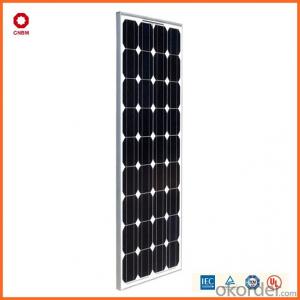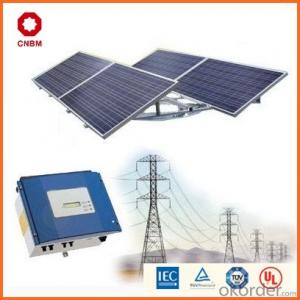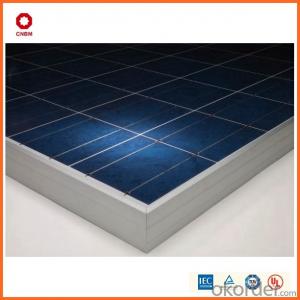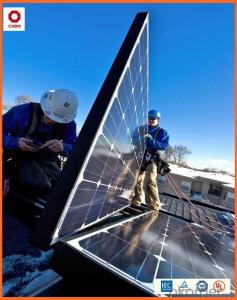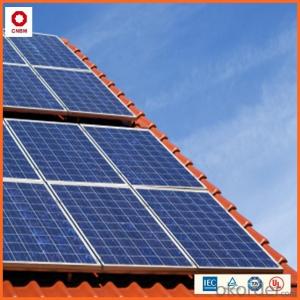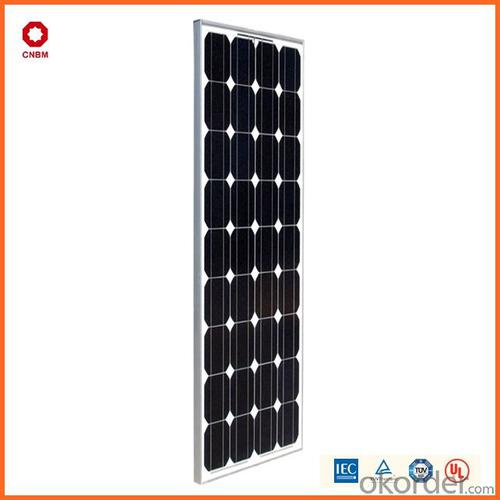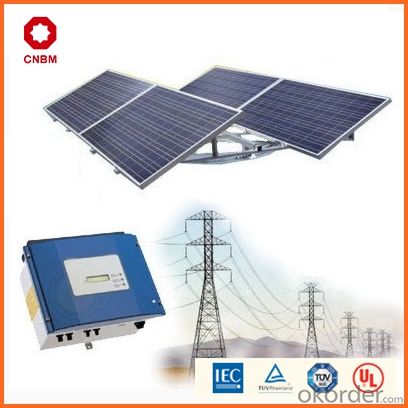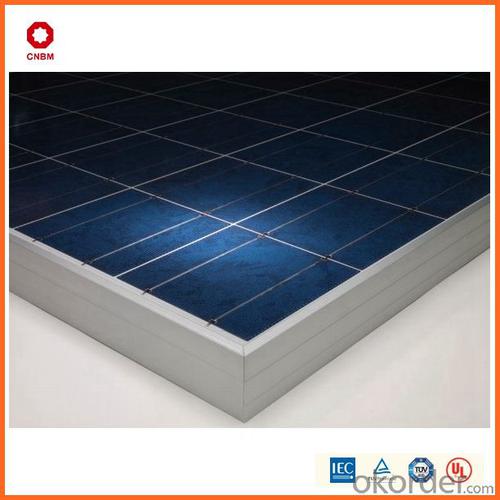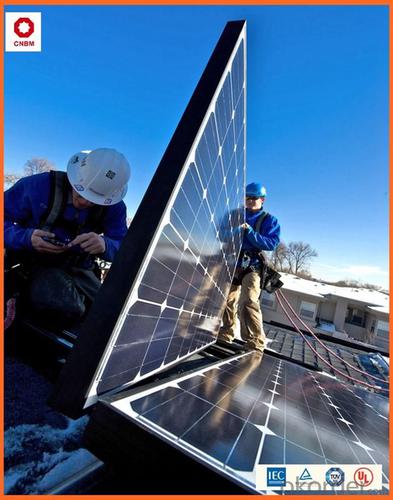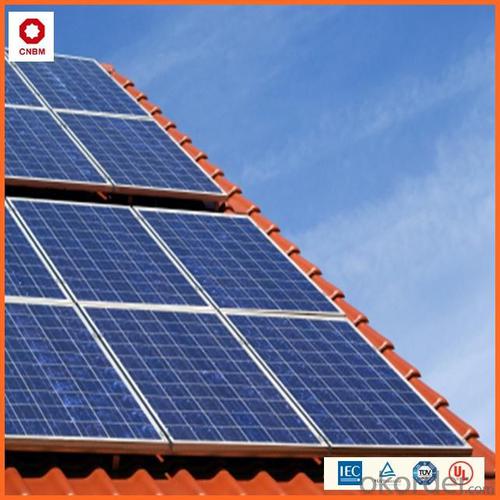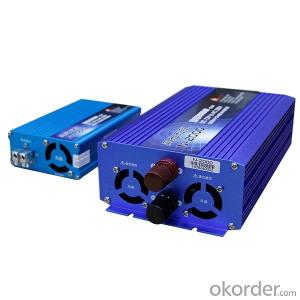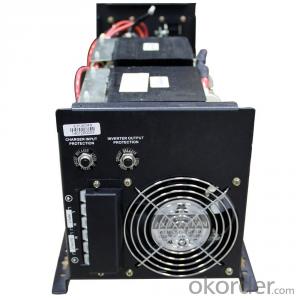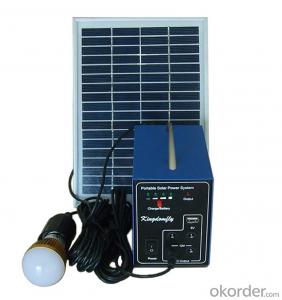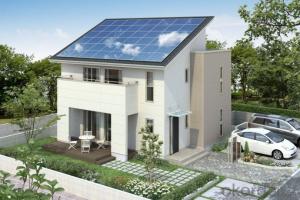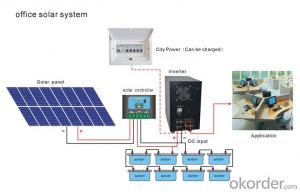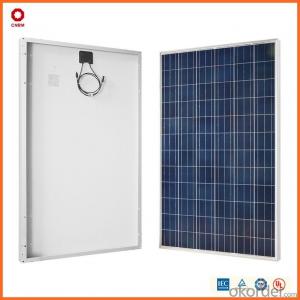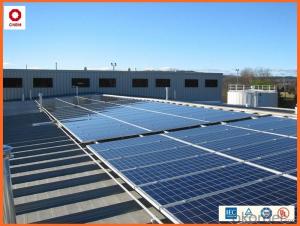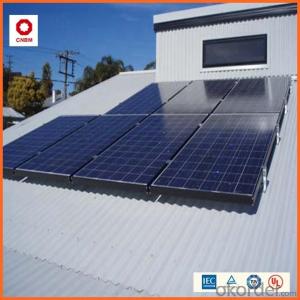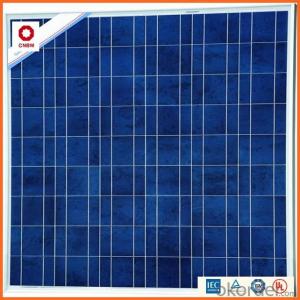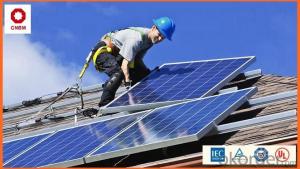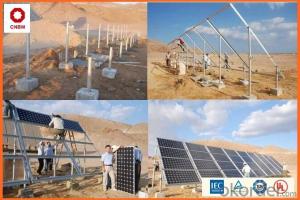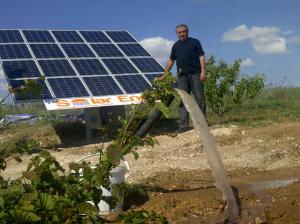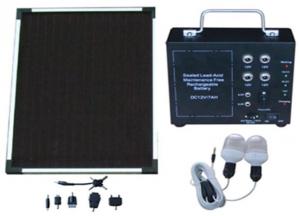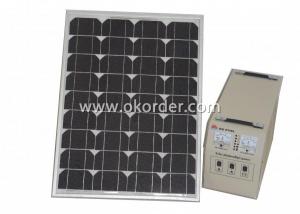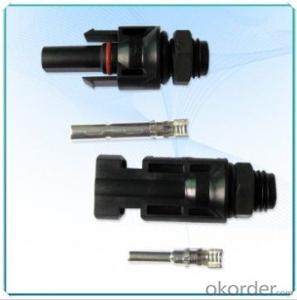75w Small Solar Panels in Stock - Solar Energy Systems New York - China Manufacturer
- Loading Port:
- China main port
- Payment Terms:
- TT OR LC
- Min Order Qty:
- 1 watt
- Supply Capability:
- 10000000 watt/month
OKorder Service Pledge
OKorder Financial Service
You Might Also Like
Specification
Product Description:
Hot Sale !!! Quality and Safety of Small Poly Solar Panel 5w~150w
1. Rigorous quality control meets the highest international standards.
2. High-transmissivity low-iron tempered glass, strong aluminium frame.
3. Using UV-resistant silicon.
4. IS09001/14001/CE/TUV/UL
Warranties of Small Poly Solar Panel 35~85w
1. 10 years limited product warranty
2. 15 years at 90% of the minimal rated power output
3. 25 years at 80% of the minimal rated power output
Specification
Characteristics of Poly solar panels CNBM (245-320W) | |||||
Max Power Voltage Vmp(V) | 30.3 | 30.8 | 31.1 | 31.4 | 31.85 |
Max Power Current Imp(A) | 7.60 | 7.64 | 7.73 | 7.81 | 7.85 |
Open Circuit Voltage Voc(V) | 36.1 | 36.6 | 37 | 37.3 | 37.68 |
Short Circuit Current Isc(A) | 8.50 | 8.55 | 8.65 | 8.75 | 8.85 |
Max Power Pm(W) | 230W | 235W | 240W | 245W | 250W |
Temperature Coefficient of Cells Poly solar panels CNBM (245-320W) | |
NOCT | 45± 2 |
Temperature Coeffucients of Isc | 0.0492 |
Temperature Coeffucients of Voc | -0.3374 |
Temperature Coeffucients of Voc | -0.4677 |
Mechanical Data of Poly solar panels CNBM (245-320W) | |
Dimension | 1638 × 982 × 40 mm |
Weight | 19.5 kg |
No. of Cells and Connections | 60 (6 ×10) |
Tolerance | 0 ~ + 5 W |
Cell | Monocrystalline Cell 156 × 156 mm |
Packing | 624 Pcs/40ft(H) Container |
Limits of Poly solar panels CNBM (245-320W) | |
Operating Temperature | -40 to +85 |
Storage Temperature | -40 to +85 |
Max System Voltage | 1000VDC(IEC) / 600VDC(UL) |
Features of our products:
• High conversion efficiency mono/poly-crystalline amorphous silicon solar cells
• Modules incorporate high performance bypass diodes to minimize the power drop caused by shading
• High transmittance, low-iron tempered glass
• High performance EVA encapsulant to prevent destroying and water.
• AI frame: without screw, corner connection. 8 holes on the frame can be installed easily
• Good performance of preventing from atrocious weather such as wind and hails
• Certifications: CE IEC TUV VDE UL, Class I
• 10 years 90% power output warranty
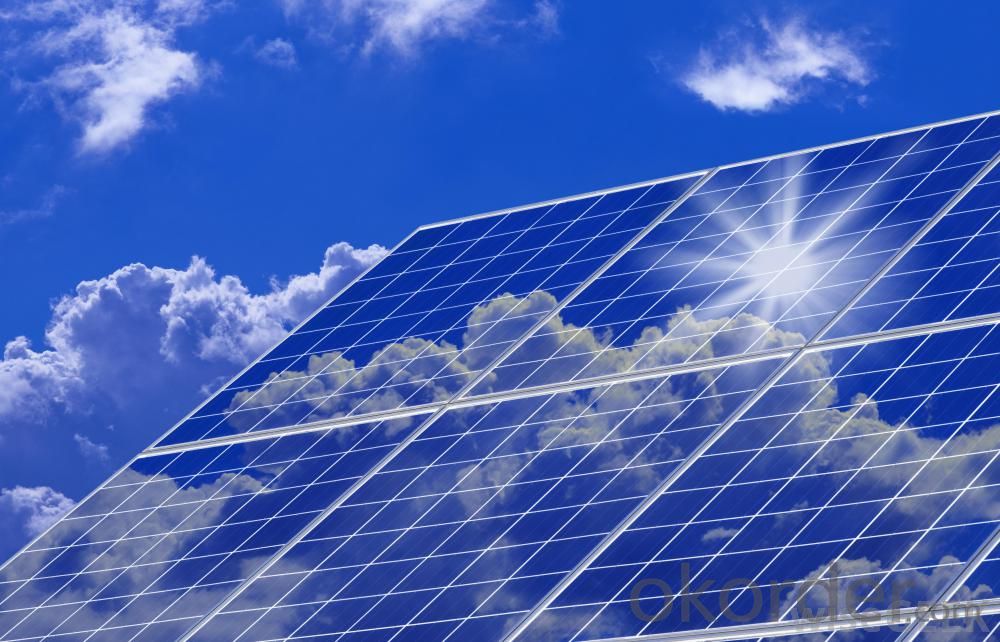
Shipping of Small Poly Solar Panel 35~85w
By Sea | Delivery from Shanghai or Ningbo seaport |
By Air | Departure from Shanghai Pudong Airport |
By Express | Post by DHL, EMS, UPS, TNT. |
Features of our products:
• High conversion efficiency mono/poly-crystalline amorphous silicon solar cells
• Modules incorporate high performance bypass diodes to minimize the power drop caused by shading
• High transmittance, low-iron tempered glass
• High performance EVA encapsulant to prevent destroying and water.
• AI frame: without screw, corner connection. 8 holes on the frame can be installed easily
• Good performance of preventing from atrocious weather such as wind and hails
• Certifications: CE IEC TUV VDE UL, Class I
• 10 years 90% power output warranty
As a professional Solar Panel manufacturer and Supplier in China, we have our customers come around the whole world and our specialization has got a worldwide recognition. Meanwhile, with our superior quality, competitive price, prompt and excellent service, As main role in trade section of CNBM Group, CNBM International Corporation supplies products including Monocrystalline Solar Panel, Polycrystalline Solar Panel ( multicrystalline silicon Solar Panel) have received and enjoyed famous reputation in many countries and regions in the world.
- Q: Can solar energy systems be used in areas with high population density?
- Yes, solar energy systems can be used in areas with high population density. Solar panels can be installed on rooftops, buildings, and other available spaces, making them suitable for densely populated areas. Additionally, advancements in solar technology and the ability to install solar farms outside urban areas can help meet the energy demands of densely populated regions.
- Q: How do solar energy systems impact the stability of the electricity supply?
- Solar energy systems can have a positive impact on the stability of the electricity supply by diversifying the energy sources and reducing reliance on traditional power plants. The decentralized nature of solar energy generation reduces the risk of large-scale blackouts and enhances grid resilience. Additionally, solar power can help meet peak electricity demand during daylight hours, reducing strain on the grid and promoting a more stable and balanced electricity supply.
- Q: Can solar energy systems be used in areas with high seismic activity?
- Yes, solar energy systems can be used in areas with high seismic activity. However, additional precautions and engineering considerations need to be taken into account during the installation and design process to ensure the system's stability and safety. This may include using reinforced mounting structures, employing flexible wiring connections, and implementing seismic-resistant designs.
- Q: Are there any disadvantages of using solar energy?
- Yes, there are a few disadvantages of using solar energy. Firstly, the initial installation cost of solar panels can be quite expensive. Additionally, solar panels can take up a significant amount of space, especially when considering large-scale installations. Furthermore, solar energy generation is dependent on sunlight availability, meaning it may not be as reliable during cloudy days or at night. Finally, the production and disposal of solar panels can have environmental impacts, as they involve the use of certain chemicals and materials.
- Q: Can solar energy systems be used for powering mining operations?
- Yes, solar energy systems can be used for powering mining operations. Solar panels can be installed on-site to generate electricity, which can then be used to power various mining equipment and operations. This can help reduce reliance on traditional energy sources, lower operating costs, and minimize the environmental impact of mining activities.
- Q: How does the quality of solar panels affect their performance?
- The performance of solar panels is greatly influenced by their quality, which is determined by various factors. Advanced technology and materials are used to design and manufacture high-quality solar panels, directly affecting their efficiency, durability, and reliability. Efficiency, a crucial aspect of solar panels, is greatly affected by their quality. High-quality panels are constructed using superior materials and advanced manufacturing techniques, enabling them to convert sunlight into electricity more effectively. As a result, they can generate more electricity from the same amount of sunlight compared to lower-quality panels. Durability, another important factor, is also influenced by the quality of solar panels. High-quality panels are specifically designed to withstand harsh weather conditions, such as extreme temperatures, strong winds, and heavy snow loads. Moreover, they are less susceptible to degradation, ensuring a longer lifespan and consistent performance over time. The quality of solar panels is closely linked to their reliability. High-quality panels are built to last, reducing the likelihood of malfunctions or breakdowns. They undergo rigorous testing and quality control processes to ensure that they can consistently deliver their rated power output for many years. Furthermore, high-quality solar panels often come with industry-leading warranties, providing reassurance to owners. These warranties cover defects, performance issues, and other potential problems, guaranteeing that customers receive support and replacements when necessary. To summarize, the performance of solar panels is greatly influenced by their quality. Investing in high-quality panels can result in increased energy production, enhanced durability, and improved reliability. Ultimately, this leads to higher returns on investment and a more sustainable energy solution.
- Q: Can solar energy systems be used for large-scale power generation?
- Yes, solar energy systems can be used for large-scale power generation. With advancements in technology and decreasing costs, solar power plants and solar farms are being built around the world to generate electricity on a large scale. These solar energy systems utilize photovoltaic panels or concentrated solar power technology to convert sunlight into electricity, making them a sustainable and renewable source of power for meeting the energy demands of entire communities or even countries.
- Q: Can solar energy systems be used in urban environments?
- Yes, solar energy systems can be used in urban environments. In fact, urban areas provide ample opportunities for the installation of solar panels on rooftops, facades, and even on the ground. Solar energy systems can be integrated into buildings, parking lots, and streetlights, making use of available space to generate clean and renewable energy in densely populated areas. Additionally, advancements in solar technology have made it possible to optimize energy production even in limited or shaded urban areas.
- Q: Can solar panels be installed on different surfaces like glass or metal?
- Yes, solar panels can be installed on different surfaces like glass or metal. In fact, solar panels are commonly installed on rooftops, which are often made of materials like glass, metal, or asphalt shingles. The most common type of solar panels, known as photovoltaic (PV) panels, are designed to be mounted on a variety of surfaces. The installation process involves securing the panels to the surface using racks or frames, ensuring that they are properly angled to maximize sunlight exposure. Whether it is a glass or metal surface, solar panels can be installed and effectively generate electricity from the sun's energy.
- Q: What is the efficiency of a solar energy system?
- The percentage of sunlight that a solar energy system is able to convert into usable electricity is what we refer to as its efficiency. This measure shows how effectively the system can harness and convert solar energy into electrical power. The efficiency of a solar energy system can vary based on several factors, including the type of solar panels used, the location and orientation of the panels, weather conditions, and the overall design and quality of the system. Commercially available solar panels typically have efficiencies ranging from 15% to 22%. This means that only a portion of the sunlight that reaches the panels is converted into electricity, while the rest is either reflected or lost as heat. However, ongoing advancements in solar technology have resulted in experimental panels that have achieved efficiencies exceeding 40%. It is worth noting that the efficiency of a solar energy system does not solely determine its overall effectiveness. Other factors, such as the cost, durability, and maintenance requirements of the system, also play a significant role in determining its overall value. Additionally, maximizing the efficiency of a system can be achieved through careful installation optimization, regular panel cleaning, and ensuring minimal obstructions to sunlight. To summarize, the efficiency of a solar energy system measures its ability to convert sunlight into electricity. While commercially available panels typically have efficiencies between 15% and 22%, ongoing technological advancements continue to improve this figure. However, other factors like cost, durability, and maintenance requirements should also be considered when evaluating the effectiveness of a solar energy system.
Send your message to us
75w Small Solar Panels in Stock - Solar Energy Systems New York - China Manufacturer
- Loading Port:
- China main port
- Payment Terms:
- TT OR LC
- Min Order Qty:
- 1 watt
- Supply Capability:
- 10000000 watt/month
OKorder Service Pledge
OKorder Financial Service
Similar products
Hot products
Hot Searches
Related keywords
